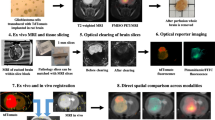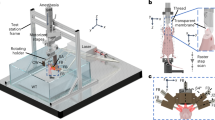Abstract
Imaging technologies are regularly used in biomedical research to study processes in living animals in a noninvasive manner. But imaging procedures can affect animal physiology, and the need to anesthetize animals for imaging entails potential health risks. In addition, certain imaging modalities require the use of ionizing radiation or the administration of contrast agents or imaging biomarkers, which also have consequences for animal physiology. Finally, procedures associated with imaging, such as animal preparation (e.g., fasting, premedication) and blood sampling, can also affect physiology and animal welfare. Here, the authors review the imaging modalities commonly used for rodents in biomedical research and their associated considerations for animal welfare.
This is a preview of subscription content, access via your institution
Access options
Subscribe to this journal
We are sorry, but there is no personal subscription option available for your country.
Buy this article
- Purchase on Springer Link
- Instant access to full article PDF
Prices may be subject to local taxes which are calculated during checkout

Similar content being viewed by others
References
Ram, R., Mickelsen, D.M., Theodoropoulos, C. & Blaxall, B.C. New approaches in small animal echocardiography: imaging the sounds of silence. Am. J. Physiol. Heart Circ. Physiol. 301, H1765–H1780 (2011).
Waerzeggersa, Y., Monfareda, P., Viela, T., Winkelera, A. & Jacobs, A. Mouse models in neurological disorders: applications of non-invasive imaging. Biochim. Biophys. Acta 1802, 819–839 (2010).
Schambach, S.J., Bag, S., Schilling, L., Groden, C. & Brockmann, M.A. Application of micro-CT in small animal imaging. Methods 50, 2–13 (2010).
de Jong, M., Essers, J. & van Weerden, W.M. Imaging preclinical tumour models: improving translational power. Nat. Rev. Cancer 14, 481–493 (2014).
Kooreman, N.G., Ransohoff, J.D. & Wu, J.C. Tracking gene and cell fate for therapeutic gain. Nat. Mater. 13, 106–109 (2014).
Matthews, P.M. et al. Technologies: preclinical imaging for drug development. Drug Discov. Today. Technol. 10, e343–e350 (2013).
Clark, D.P. & Badea, C.T. Micro-CT of rodents: state-of-the-art and future perspectives. Phys. Med. 30, 619–634 (2014).
Bouxsein, M.L. et al. Guidelines for assessment of bone microstructure in rodents using micro-computed tomography. J. Bone Miner. Res. 25, 1468–1486 (2010).
Hallouard, F., Anton, N., Choquet, P., Constantinesco, A. & Vandamme, T. Iodinated blood pool contrast media for preclinical X-ray imaging applications—a review. Biomaterials 31, 6249–6268 (2010).
Bartling, S.H., Kuntz, J. & Semmler, W. Gating in small-animal cardio-thoracic CT. Methods 50, 42–49 (2010).
Driehuys, B. et al. Small animal imaging with magnetic resonance microscope. ILAR J. 49, 35–53 (2008).
Albanese, C. et al. Preclinical magnetic resonance imaging and systems biology in cancer research: current applications and challenges. Am. J. Pathol. 182, 312–318 (2013).
Botnar, R.M. & Makowski, M.R. Cardiovascular magnetic resonance imaging in small animals. Prog. Mol. Biol. Transl. Sci. 105, 227–261 (2012).
Lee, M.R. et al. Preclinical (1) H-MRS neurochemical profiling in neurological and psychiatric disorders. Bioanalysis 4, 1787–1804 (2012).
Chao, T.H., Chen, J.H. & Yen, C.T. Repeated BOLD-fMRI imaging of deep brain stimulation responses in rats. PLoS ONE 9, e97305 (2014).
Baltes, C., Radzwill, N., Bosshard, S., Marek, D. & Rudin, M. Micro MRI of the mouse brain using a novel 400 MHz cryogenic quadrature RF probe. NMR Biomed. 22, 834–842 (2009).
Uhrig, L., Ciobanu, L., Djemai, B., Le Bihan, D. & Jarraya, B. Sedation agents differentially modulate cortical and subcortical blood oxygenation: evidence from ultra-high field MRI at 17.2 T. PLoS ONE 9, e100323 (2014).
Schmid, A. et al. Feasibility of sequential PET/MRI using a state-of-the-art small animal PET and a 1 T benchtop MRI. Mol. Imaging Biol. 15, 155–165 (2013).
Riemann, B., Schäfers, K.P., Schober, O. & Schäfers, M. Small animal PET in preclinical studies: opportunities and challenges. Q. J. Nucl. Med. Mol. Imaging 52, 215–221 (2008).
Magota, K. et al. Performance characterization of the Inveon preclinical small-animal PET/SPECT/CT system for multimodality imaging. Eur. J. Nucl. Med. Mol. Imaging 38, 742–752 (2011).
Khalil, M.M., Tremoleda, J.L., Bayomy, T.B. & Gsell, W. Molecular SPECT imaging: an overview. Int. J. Mol. Imaging 2011, 796025 (2011).
Franc, B.L., Acton, P.D., Mari, C. & Hasegawa, B.H. Small-animal SPECT and SPECT/CT: important tools for preclinical investigation. J. Nucl. Med. 49, 1651–1663 (2008).
Keyaerts, M., Caveliers, V. & Lahoutte, T. Bioluminescence imaging: looking beyond the light. Trends Mol. Med. 18, 164–172 (2012).
Zelmer, A. & Ward, T.H. Noninvasive fluorescence imaging of small animals. J. Microsc. 252, 8–15 (2013).
Frangioni, J.V. In vivo near-infrared fluorescence imaging. Curr. Opin. Chem. Biol. 7, 626–634 (2003).
Leblond, F., Davis, S.C., Valdes, P.A. & Pogue, B.W. Pre-Clinical whole-body fluorescence imaging: review of instruments, methods and applications. J. Photochem. Photobiol. B. Biol. 98, 77–94 (2010).
Conway, J.R.W., Carragher, N.O. & Timpson, P. Developments in preclinical cancer imaging: innovating the discovery of therapeutics. Nat. Rev. Cancer 14, 314–328 (2014).
Foster, F.S., Pavlin, C.J., Harasiewicz, K.A., Christopher, D.A. & Turnbull, D.H. Ultrasound biomicroscope for mouse imaging. Ultrasound Med. Biol. 26, 1–27 (2000).
Moran, C.M., Thomson, A.J., Rog-Zielinska, E. & Gray, G.A. High-resolution echocardiography in the assessment of cardiac physiology and disease in preclinical models. Exp. Physiol. 98, 629–644 (2013).
Wang, L.V. & Hu, S. Photoacoustic tomography: in vivo imaging from organelles to organs. Science 335, 1458–1462 (2012).
Lovell, D.P. Variation in pentobarbitone sleeping time in mice. 1. Strain and sex differences. Lab. Anim. 20, 85–90 (1986).
van Bogaert, M.J. et al. Mouse strain differences in autonomic responses to stress. Genes Brain Behav. 5, 139–149 (2006).
Curry, B.B. III. Animal models used in identifying gender-related differences. Int. J. Toxicol. 20, 153–160 (2001).
Vermeulen, J.K., De Vries, A., Schlingmann, F. & Remie, R. Food deprivation: common sense or nonsense? Anim. Technol. 48, 45–54 (1997).
Hedrich, H. (ed.) The Laboratory Mouse: The Handbook of Experimental Animals (Elsevier, San Diego, 2004).
Troy, T., Jekic-McMullen, D., Sambucetti, L. & Rice, B. Quantitative comparison of the sensitivity of detection of fluorescent and bioluminescent reporters in animal models. Mol. Imaging 3, 9–23 (2004).
MacLaurin, S.A. et al. Reduction of skin and food auto fluorescence in different mouse strains through diet changes. 2006. Poster, Society for Molecular Imaging, Annual Meeting, Hawaii.
Diehl, K.H. et al. A good practice guide to the administration of substances and removal of blood, including routes and volumes. J. Appl. Toxicol. 21, 15–23 (2001).
Hildebrandt, I.J., Su, H. & Weber, W.A. Anesthesia and other considerations for in vivo imaging of small animals. ILAR J. 49, 17–26 (2008).
Moadel, R.M. et al. Positherapy: targeted nuclear therapy of breast cancer with 18F-2-deoxy-2-fluoro-D-glucose. Cancer Res. 65, 698–702 (2005).
Taschereau, R., Chow, P.L. & Chatziioannou, A.F. Montecarlo simulations of dose from micro CT imaging procedures in a realistic mouse phantom. Med. Phys. 33, 216–224 (2006).
Flecknell, P.A. Laboratory Animal Anaesthesia 3rd edn. (Academic, San Diego, 2009).
Wolfensohn, S. & Lloyd, M. (eds.) Anaesthesia of laboratory animals in Handbook of Laboratory Animal Management and Welfare 3rd edn. (Blackwell, Ames, IA, 2003).
Johnson, R.A., Striler, E., Sawyer, D. & Brunson, D. Comparison of isoflurane with sevoflurane for anaesthesia induction and recovery in adult dogs. Am. J. Vet. Res. 59, 478–481 (1998).
Cesarovic, N. et al. Isoflurane and sevoflurane provide equally effective anaesthesia in laboratory mice. Lab. Anim. 44, 329–336 (2010).
Wagner, A.E. & Brodbelt, D.C. Arterial blood pressure monitoring in anesthetized animals. J. Am. Vet. Med. Assoc. 210, 1279–1285 (1997).
Thal, S.C. & Plesnila, N. Non-invasive intraoperative monitoring of blood pressure and arterial pCO2 during surgical anesthesia in mice. Neurosci Meth. 159, 261–267 (2007).
Makowska, I.J. & Weary, D.M. Rat aversion to induction with inhalant anaesthetics. Appl. Anim. Behav. Sci. 119, 229–235 (2009).
Hauber, H.P., Karp, D., Goldmann, T., Vollmer, E. & Zabel, P. Effect of low tidal volume ventilation on lung function and inflammation in Mice. BMC Pulm. Med. 10, 21 (2010).
Pecchiari, M. et al. Effects of various modes of mechanical ventilation in normal rats. Anesthesiology 120, 943–950 (2014).
Colby, L.A. & Morenko, B.J. Clinical considerations in rodent bioimaging. Comp. Med. 54, 623–630 (2004).
Cherry, S.R. Multimodality imaging: Beyond PET/CT and SPECT/CT. Semin. Nucl. Med. 39, 348–353 (2009).
Wehrl, H.F. et al. Preclinical and translational PET/MR imaging. J. Nucl. Med. 55 (suppl. 2), 11S–18S (2014).
Guo, X. et al. A combined fluorescence and microcomputed tomography system for small animal imaging. IEEE Trans. Biomed. Eng. 57, 2876–2883 (2010).
Nahrendorf, M. et al. Hybrid PET-optical imaging using targeted probes. Proc. Natl. Acad. Sci. USA 107, 7910–7915 (2010).
Author information
Authors and Affiliations
Corresponding author
Ethics declarations
Competing interests
The authors declare no competing financial interests.
Rights and permissions
About this article
Cite this article
Tremoleda, J., Sosabowski, J. Imaging technologies and basic considerations for welfare of laboratory rodents. Lab Anim 44, 97–105 (2015). https://doi.org/10.1038/laban.665
Received:
Accepted:
Published:
Issue Date:
DOI: https://doi.org/10.1038/laban.665



